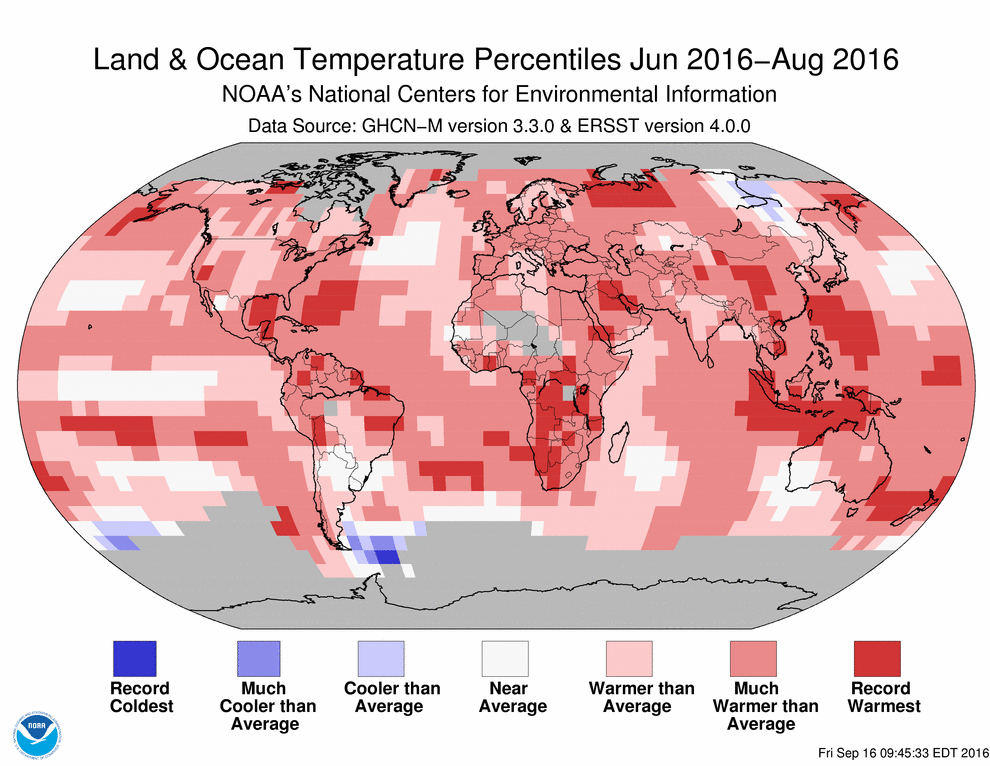Rebuilding Healthy Soil for a Changing Climate
http://blogs.worldwatch.org - Wanqing Zhou
To celebrate the recent World Food Day (October 16), learn how food production can be transformed from a greenhouse gas emitter to a carbon sink by improving soil biology.
“Climate is changing. Food and agriculture must too.” This year’s message from the United Nations Food and Agriculture Organization for World Food Day is timely as the planet emerges from yet another summer of record heat. (See Figure 1.) With changing climates and increasingly frequent extreme weather events, the world is facing real challenges with food production, exacerbated by the declining capacity of soils to hold water, buffer temperature shocks, and supply nutrients to food crops.

Figure 1. Much of the world experienced record-high temperatures during June-August 2016.
Source: NOAA Global Temperature and Precipitation Maps
In global climate negotiations and agreements, agriculture is listed primarily as a victim of adverse climate impacts. While this is true, it is equally important to recognize that food production is also a major contributor to climate change. The silver lining? Recognizing that food production is a major emitter of greenhouse gases could open a new range of solutions to climate change.
Agriculture as a Climate Change Contributor
According to the Intergovernmental Panel on Climate Change, over a 20-year period, agriculture accounts for about 22 percent of global greenhouse gas emissions. This makes agriculture the largest contributing sector to climate change. In comparison, industry emits 20 percent of greenhouse gases, electricity and heat production 17 percent, and other energy–related activities another 17 percent. (See Figure 2.)

Figure 2. Contributions by sectors to total greenhouse gas emissions using 20-year global warming potentials.
Source: IPCC AR5
Agriculture’s 20-year impact is comparatively high because, unlike other sectors where carbon dioxide (CO2) is the major greenhouse gas, agricultural emissions include high levels of methane and nitrous oxide. These greenhouse gases create a much greater warming effect than CO2. For comparison, over a 20-year time frame, methane is 86 times stronger a greenhouse gas than CO2, and nitrous oxide is 268 times stronger.
The main sources of agricultural methane and nitrous oxide include animal farming and the use of fertilizers in crop cultivation. Moreover, concentrated animal farming and industrial monoculture cropping have undermined the greenhouse gas-absorbing capacities of the soil system by reducing the diversity and activity of some of Earth’s most essential living beings: soil microorganisms.
Agriculture as a Climate Change Solution
There is good news, however. Because the agricultural system is a living community, its capacity for greenhouse gas sequestration can regrow organically under management practices that allow the soil ecosystem to recover and thrive.
To do this, farmers have to switch to methods that minimize soil disturbance, embrace diversity, and mimic natural processes. They can replace pesticides with natural pest control methods such as “beneficial” insects and animal species, use cover crops and microbe-rich composts to improve soil nutrients and biology, maintain soil structure through reduced or no tilling, and implement crop rotation and intercropping, management-intensive rotational grazing, and integrated livestock and crop systems. (See Figure 3.)
 Figure 3. Integrated livestock-crop rotation management system at Rodale Institute, which provides data on soil improvement, carbon sequestration, energy efficiency, and economic effects. Photo by Wanqing Zhou
Figure 3. Integrated livestock-crop rotation management system at Rodale Institute, which provides data on soil improvement, carbon sequestration, energy efficiency, and economic effects. Photo by Wanqing Zhou
These ecosystem-regenerating practices have been recognized by some climate initiatives as key actions that help agriculture and food producers reduce emissions and adapt to a changing climate.
According to Rodale Institute, a Pennsylvania-based pioneering organic agriculture research organization, primary studies suggest that regenerative farming and ranching practices have the potential to turn food production into a net greenhouse gas sink. If regenerative farming were scaled up on all croplands and pastures worldwide, the world could potentially sequester up to 58 billion tons of CO2. That is nearly 120 percent of the estimated total human-caused greenhouse gas emissions generated worldwide in 2010 (47.7–49 billion tons of CO2-equivalent). All of this carbon capture and storage would be accomplished through techniques that are low cost and widely available.
Regenerative farming and ranching practices can further help by reducing crop loss during extreme weather events. Crop diversity and healthy soil help enhance the farmers’ capacity to adapt to climate uncertainties, especially for smallholders. If the practices that promote crop diversity and soil health were embraced by farms all over the world, more disaster-resilient crops grown “by the local and for the local” could mean more stable yields, fewer market shocks, better local economies, and stronger food security for communities, cities, and countries.
Leveraging the Soil Transition
To accelerate the transition toward climate resilience and mitigation, better data monitoring of farms is needed. Many regenerative organic farmers and ranchers have observed soil improvement and ecosystem recovery on their land. However, invaluable long-term data, which can showcase the practices’ real capacity of climate mitigation and adaptation, is currently being lost due to limited resources and time for soil testing and other surveys. Some agricultural extension programs and universities have been providing soil testing services, but the coverage, especially for transitioning farms that are experiencing soil changes, is not enough.
By asking questions and facilitating the studies to answer these questions, a wide-angle and high-resolution scientific evaluation would be possible, and the results can help decision making at all levels toward a food system that stays healthy under the changing climate. These numbers, as well as convincing studies that compare nutrient contents between regeneratively and conventionally produced foods, are key missing pieces that can potentially catalyze strategic changes in large food producers and retailers to leverage a large-scale transition. In order to build climate resilience and mitigation, collective action from producers, consumers, researchers, businesses, and policymakers will be needed.
